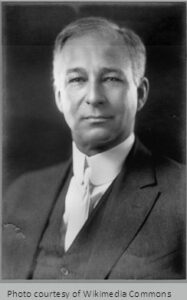By Laura Arksey (M85751)
I live in the Willamette Valley of Oregon, an agricultural area in which blueberries are a major crop. Everywhere I go, I see blueberry fields. Of course, this fruit is also a mainstay of local gardens, including those of the retirement community where I live. In 2016, the Oregon Blueberry Commission celebrated the centennial of commercial blueberry farming.
Imagine my surprise, then, to learn that the botanist behind the scientific domestication of wild blueberries was a More: Frederick Vernon Coville (8.11.3). We were informed of this achievement by his great granddaughter, Patricia Marie (Thompson) Ryan (8.11.3.213) at the 2022 JMA reunion. She subsequently provided important information for this article.
Frederick V. Coville was born at Preston, Chenango County, New York, in 1867 and graduated from Cornell University in 1887 at age 20, the leading scholar and athlete in his class. Soon after college, he joined the U.S. Department of Agriculture as a botanist and remained there until his death in 1937. In
this capacity, he had a leadership role in both the National Herbarium and the National Arboretum. During his tenure at USDA, Coville produced approximately 170 scientific papers and books, winning various awards for his achievements.
Coville’s growing reputation qualified him for membership in Washington’s prestigious Cosmos Club, composed of high-achieving men in the sciences and public life. His great granddaughter remembers once seeing, in a suitcase of his memorabilia, a photo of Coville sitting with Theodore Roosevelt and other men in tuxedos at the Cosmos Club. Sadly, this material was discarded by a later generation.
Early in his career, Frederick Coville participated as the botanist for two important scientific expeditions: the Death Valley Exploration Expedition of 1890-91 and the Harriman Alaska Expedition of 1899. The first resulted in his 1893 book Botany of the Death Valley Expedition, still available as a reprint.
Coville had a long affiliation with the National Geographic Society. A Society photograph from 1909 pictures him with the likes of North Pole explorer Robert Peary; Roald Amundsen, discoverer of the South Pole; the aged Alexander Graham Bell; ambassadors of several countries; and other notables. Coville was identified in the photo as President of the Washington Academy of Sciences. From 1920 until his death, he was chairman of the National Geographic Society Research Committee.
Coville’s interest in the domestication of wild blueberries began some time before 1910. His great granddaughter reports, “It all started when he was out walking in New Hampshire near his summer retreat and discovered both the highbush and lowbush wild blueberries. He decided to cross hybridize them.” In one of those rare coincidences in science, a woman in New Jersey was thinking along the same lines. Elizabeth Coleman White’s father managed a large cranberry farm where she often worked in the summers. She became intrigued with the wild blueberries scattered about the farm and wondered if they could be improved for commercial purposes.
White read Coville’s 1910 USDA bulletin “Experiments in Blueberry Culture” and offered him some unused farmland for his experiments. The goal was to improve the color, taste, size, yield, resistance to cold, and other advantages over the wild berries. One of Coville’s various conclusions was that blueberries require acidic soil. Together Coville and White produced the first commercial blueberry crop in 1916,
marketing it under the name Tru-Blu-Berries. Their continuing collaboration led to what is now a billion-dollar industry. In 1932, New Jersey honored Elizabeth White for “outstanding contributions to agriculture.”
Frederick Coville married Elizabeth Harwood Boynton, a fellow Cornell graduate, in 1890. They had five children. Amid all his scientific endeavors, he found time for the More Family, serving on the Permanent Committee from 1920 until his death in 1937. Coville attended many reunions, often leading hikes to the Catskill farm sites of the early Mores. According to a report on the 1920 reunion, he was “always searching for herbs and berries that might have been used by the housewife in that home.” (Chronicles of the More Family, p. 121) No doubt he kept a sharp lookout out for wild blueberries!
Sources
“The Fascinating History of Blueberries.” https://www.lancasterfarming.com/country-life/the-fascinating-history-of-blueberries/ article_d5f11691-23fe-57a7-968e-60fd5f659e76.html
“Meet Tumamoc’s Pioneers and Heroes: Frederick Vernon Coville.” https://tumamoc.org/Coville.html
More, David Fellows. The History of the More Family. (Binghampton, NY, 1893)
More, Grace Van Dyke, ed. Chronicles of the More Family. (Roxbury, N.Y., John More Association, 1955)
Ryan, Patricia Marie (Thompson). Email accessed April 4, 2024.
U.S. Department of Agriculture. “The Woman Who Cultivated a Billion-Dollar Industry.” https://www.usda.gov/media/blog/2012/03/15/ woman-who-cultivated-billion-dollar-industry
Wikipedia postings on Coville and White

